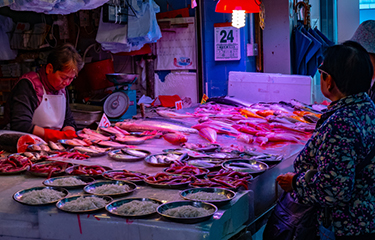The rising global demand for seafood and a projected slowdown in the growth of fisheries and aquaculture production, particularly by China – the world’s leading provider of these products – will lead to a decade of higher prices, anticipates the Food and Agriculture Organization of the United Nations (FAO).
In 2016, total fish production reached an all-time high of 171 million metric tons (MT), with wild-capture fisheries and aquaculture providing 53 percent and 47 percent respectively. Of the total, 88 percent or 151 million MT was utilized for direct human consumption. Capture fisheries production accounted for 90.9 million MT, while aquaculture supplied 80 million MT. Although the contribution of farmed species to human consumption is higher than that of wild-caught fish.
Based on the assumption of higher demand and technological improvements, the overall production is expected to continue to expand, reaching 201 million MT by 2030. While this would represent a growth of 18 percent or 30 million MT over 2016, it amounts to an annual growth rate of just 1 percent for the 2016-2030 period, compared with 2.3 percent for 2003-2016.
By 2030, the FAO expects capture fisheries production to reach about 91 million MT, only 1 percent more than in 2016. It foresees that factors influencing this limited growth will include a 17 percent decrease of capture fisheries in China due to the implementation of new policies, which it reckons will be compensated for by increased catches in a number of other regions. In this regard, it believes there will be higher landings from fishing areas where stocks of certain species are recovering due to improved management, as well as increased catches in waters of the few countries where there are underfished resources, as well as where new fishing opportunities exist or where fisheries management measures are less restrictive.
In addition, the FAO believes there’ll be enhanced use of fisheries production, including reduced onboard discards, waste, and losses as driven by legislation or higher market fish prices. But it also acknowledges that in some years, the El Niño phenomenon can be expected to reduce catches in South America, especially for anchoveta, resulting in an overall decrease of world capture fisheries production of about 2 percent in those years.
The main growth in total production is expected to originate from aquaculture, which is projected to reach 109 million MT in 2030, up 37 percent over 2016. However, it’s also estimated that aquaculture’s annual growth rate will slow from the level of 5.7 percent seen for 2003–2016 to 2.1 percent for 2017–2030. This will mainly be because of the reduced growth of Chinese aquaculture production, although this will be part-compensated by increased production in other countries.
According to the FAO, the slowdown in Chinese fisheries and aquaculture production will stimulate higher prices in China, with a “domino effect” on world prices. The increase in the average price of farmed fish (19 percent over the projection period) will be greater than that of capture fish for human consumption (17 percent). Coupled with strong demand for seafood, these elevated prices will stimulate a 25 percent increase in the average price of internationally traded fish by 2030 relative to 2016.
Furthermore, fishmeal and fish oil prices are expected to continue trending upwards over the projection period, with growth levels of 20 percent and 16 percent respectively in nominal terms as a result of strong global demand. The FAO also suggests that the high feed prices could have an impact on the future species composition in aquaculture, with a shift toward those products requiring less expensive and/or lower quantities of feed or no feed.
In real terms, adjusted for inflation, it’s assumed that all prices will decline slightly over the projection period, but will nevertheless remain high, states the FAO. Moreover, for individual fishery commodities, price volatility could be more pronounced as a result of supply or demand swings.
As aquaculture is expected to represent a higher share of world fish supply, the sector could have a stronger impact on price formation in the overall seafood sector.







